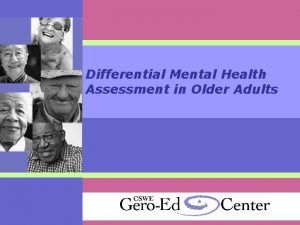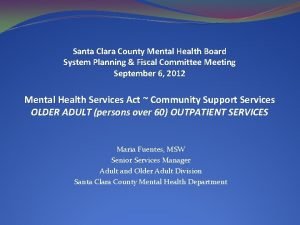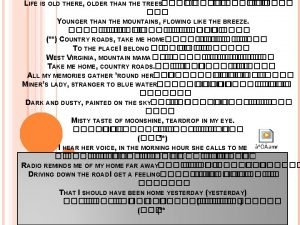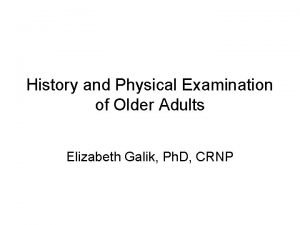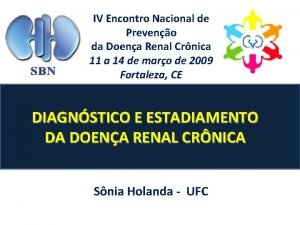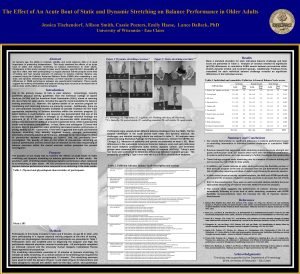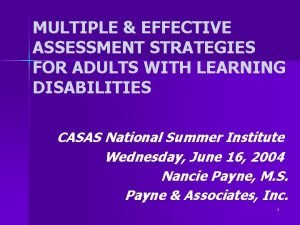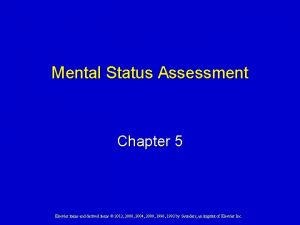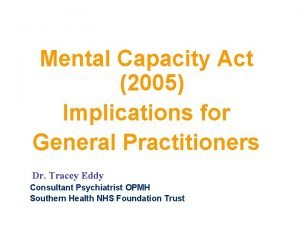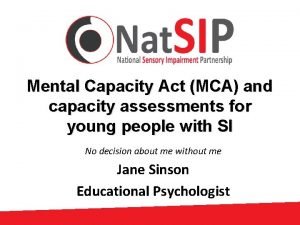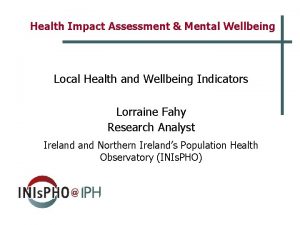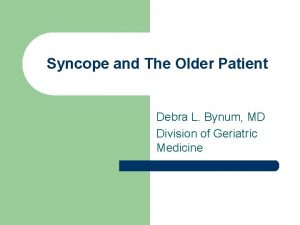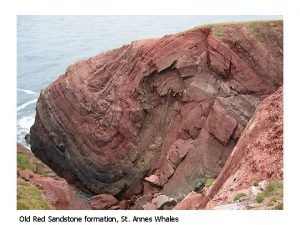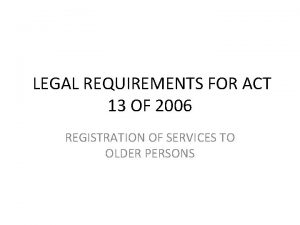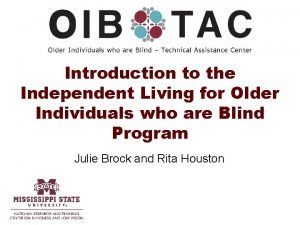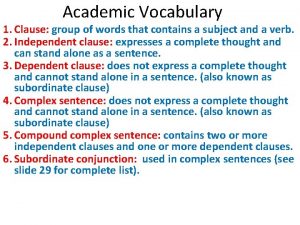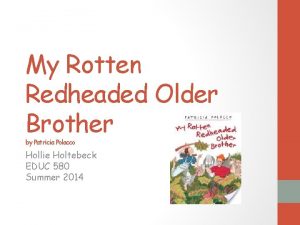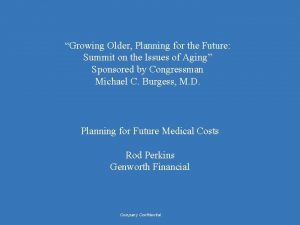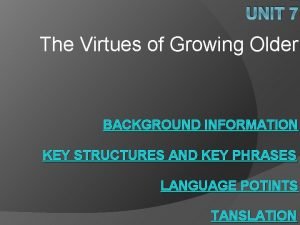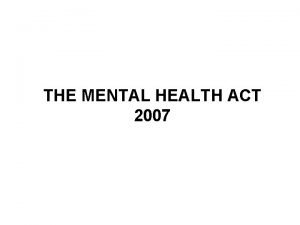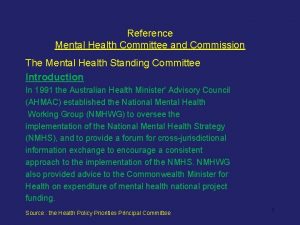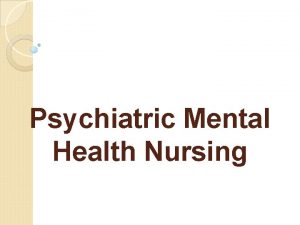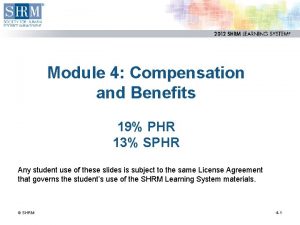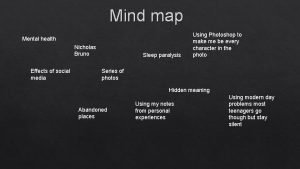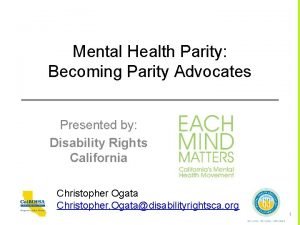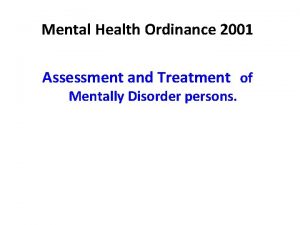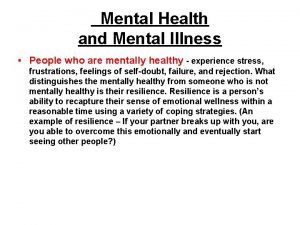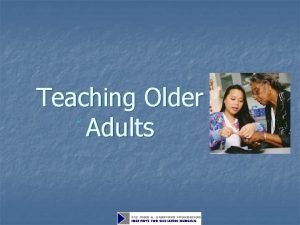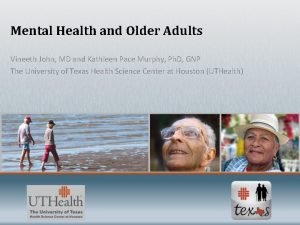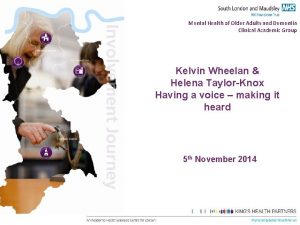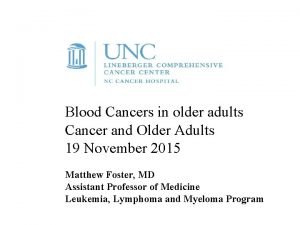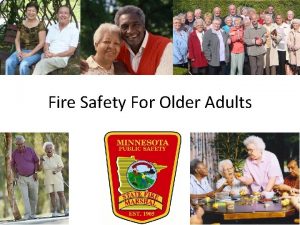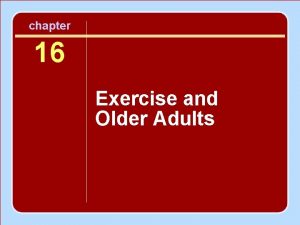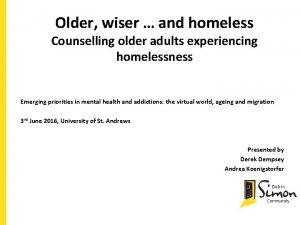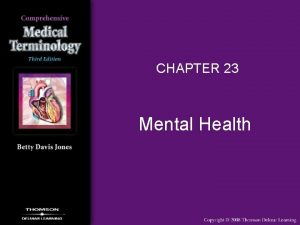Differential Mental Health Assessment in Older Adults Acknowledgements









































































- Slides: 73

Differential Mental Health Assessment in Older Adults

Acknowledgements The development of this Power. Point was made possible through a Gero Innovations Grant from the CSWE Gero-Ed Center’s Master’s Advanced Curriculum (MAC) Project and the John A. Hartford Foundation.

Myths Associated with Aging (Hooyman & Kivak, 2008) § Pathology is a normative aspect of aging. § Depression. § Cognitive impairment. § Confusion is normal and just a part of getting older. § Any sign of cognitive impairment must be dementia. § Older adults rarely use street drugs. § Ongoing grief and pain is an expected part of old age. § Older adults do not have sex. Ever.

Differential Assessment in Older Adults (Zarit & Zarit, 2007) § Complicated by Presence or Sensitivity to: § Overlapping and interacting symptoms of mental health and physical problems. § Stroke/Trans Ischemic Attacks (TIA’s) § Nutritional or Metabolic changes § Infections § Medications § Frequent Pain § Stigma/lack of awareness associated with mental illness. § Experience of multiple losses

General Components of Assessments with Older Adults Adapted from: Karel, Ogland-Hand & Gatz (2002, pp. 40 -41) § Mental Status Exam § Presenting Problem: Onset, course, symptoms and functional impact of the current problem. § Medical and Psychiatric Treatment History § Family Psychiatric Treatment History § Current Medications § Substance abuse history § Developmental history: Birth, origin, schooling § Occupational History: work, military service, retirement, financial status. § Social History: marriage/partnering, children, social supports.

General Components of Assessments with Older Adults § Risk Assessment § Pain Assessment § Spiritual Assessment (Nelson-Becker, et. al. , 2007). § Do you have a faith life? What spiritual practices do you engage in currently? § Have you ever experienced a severe loss or trauma in your life? How did you/do you cope with that experience? § Utilize cognitive, mental health and alcohol and substance use screening instruments following rapport building.

Important Screening Instruments § Geriatric Depression Scale-Short (GDS) (Sheikh, et al. , 1986): 15 item screen for depression. Score >5 indicates further assessment. Score > 10 almost always indicate depression. § Confusion Assessment Method (CAM)-Short (Inouye, et al. , 1990): Screen for Delirium. § Mini Mental State Exam (MMSE) (Folstein, et al. 1975): 11 - question measure that tests five areas of cognitive function: orientation, registration, attention and calculation, recall, and language. The maximum score is 30; 23 or lower indicative of impairment. 5 minutes to administer – should be used routinely/repeatedly. § Michigan Alcohol Screening Test Short Form Geratric Version (SMAST-G) (Blow, 1991): 10 -item screening test. Further assessment warranted in case of ‘Yes’ to two or more questions.

Common Physical Conditions with Co. Morbid Psychiatric Symptoms (Blazer, 2002; Carnethon et al. 2007; Cummings & Mega, 2003; Desai, 2004; Hooyman & Kivak, 2008; Weintraub & Stern, 2005; Zarit & Zarit, 2007) § Chronic Obstructive Pulmonary Disease (Anxiety, Delirium, Depression). § Diabetes Type I & II (Depression, Delirium) § Parkinson Disease (Depression, Cognitive Impairment, Delirium, Psychosis) § Multiple Sclerosis (Depression, Delirium, Psychosis) § Huntington’s Disease (Depression, Delirium, Psychosis) § Stroke (Depression, Delirium, Psychosis, Cognitive Impairment/Dementia) § Urinary Tract Infections (Delirium)

Common Physical Conditions with Co. Morbid Psychiatric Symptoms (Blazer, 2002; Carnethon et al. 2007; Cummings & Mega, 2003; Desai, 2004; Hooyman & Kivak, 2008; Weintraub & Stern, 2005; Zarit & Zarit, 2007) § Cancer (Depression, Delirium) § Thyroid conditions (Depression, Psychosis) § Nutritional Deficiencies (Delirium, Depression) § Vitamin B 12 Deficiency (Delirium, Depression) § Hearing or Vision loss (Depression, Mask as Cognitive Impairment) § Loss of mobility due to fractures, chronic pain or arthritis (Depression, Delirium) § Dementia (Depression, Delirium, Psychosis)

Common medications that can produce psychiatric symptoms in older adults (Adapted from Desai, 2004) Drug Class Indication Side Effects Antihistamines: Diphenhydramine (Benadryl) sold OTC Allergies Delirium, Visual Hallucinations Antihypertensives Hypertension Depression, Hallucinations Benzodiazepines Anxiety Delirium, Dementia, Hallucinations Tri-cyclic Antidepressants Depression, anxiety, itching, urinary incontinence, neuropathic pain Delirium, Hallucinations Selective Serotonin Reuptake Inhibitors Depression Agitation, Sleep Disturbances, Anxiety Antipsychotics Psychosis Delirium, Hallucinations, Anxiety

Common medications that can produce psychiatric symptoms in older adults (Adapted from Desai, 2004) Drug Class Indication Side Effects Analgesics Pain Delirium Antispasmotics Urinary incontinence Cognitive impairment Anticonvulsants Tremors Delirium, Dementia Irritable bowel syndrome IBS-related pain, diarrhea Delirium, Hallucinations Corticosteroids Inflammation Hallucinations, depression, mania , delirium, Anxiety Anti-Parkinson’s Medications Parkinson’s Disease Interferon-A Antiviral Medication Psychosis, delirium, depression Depression, Delirium Digoxin/Digitalis Heart Medication Delirium, Depression, Visual Hallucinations Antitussives such as Dextromethorphan sold OTC Decongestant (sold OTC) Delirium, Visual Hallucinations

Assessing the ‘ 3 D’s’ in Older Adults (Zarit & Zarit, 2007) § Depression, Dementia and Delirium are three syndromes with many overlapping symptoms including: § Confusion § Apathy/Anhedonia § Emotional Lability § Irritability § Lack of concentration § Memory Problems § Appetite Changes/Eating Problems

Depression and Older Adults § Depression is the most common mood disorder among older adults (Dorfman, et. Al. , 1995). § 20% of depressed patient endure a chronic course with no remission (Thornicroft & Sartorius, 1993). § Co-morbidity is high among older adults with depression and another medical or neurological disorder (Alexopoulos, 2005; Hooyman & Kivak, 2008). § Older adults may be more willing to consult with their primary care physician than with a mental health professional (Dorfman, et. Al. , 1995). § Hospital stays are twice as long for older adults who have co-morbid depression 1995). (Dorfman, et. al. ,

Societal Impacts of Depression § Depression is the 4 th leading contributor to global burden of disease. Expected to be 2 nd only to Ischemic Heart Disease worldwide and 1 st in developed nations by 2020 (Chisholm et al. , 2003). § Depression amplifies the negative impact of other medical conditions. § Co-morbid with alcohol and substance abuse, violence and suicide.

Societal Impacts of Depression (cont. ) § 15 -20% of depressed patients end their lives by suicide (Goodwin & Jamison 1990). § 80% receive some benefit from treatment, but less than half receive treatment (Reiger et al. , 1993). § Prevalence of MDD in older adults range from 1 -5% in community dwelling population, but prevalence rises to 13. 5 percent in older adults who require home healthcare and to 11. 5 percent in older hospital patients (Hybels & Blazer, 2003)

DSM –IV-TR Criteria for Major Depressive Disorder (APA, 2000) § Five (or more) of the following symptoms have been present during the same two week period and represent a change from previous functioning; at least one of the symptoms is either (1)depressed mood or (2) loss of interest or pleasure. § Depressed Mood (most of the day/everyday) § Loss of interest or pleasure (anhedonia) § Significant weight change (more than 5% in a month) or significant appetite disturbance nearly every day § Sleep problems nearly every day (insomnia/hypersomnia) § Psychomotor agitation/retardation nearly every day § Chronic fatigue/loss of energy nearly everyday § Excessive feelings of worthlessness/guilt nearly everyday § Diminished ability to think or concentrate nearly everyday § Recurrent thoughts of death/dying/suicidal ideation

Depression in Older Adults: Why is it missed? (Hooyman & Kivak, 2008; NIMH, 2003; Zarit & Zarit, 2007) § Erroneously perceived as a normal part of aging process by clinicians. § Co-morbid with other medical conditions. § Can be result of multiple medications (Fick et al. , 2003) § Lack of clinician training § Majority of depression seen in primary care medical settings. § Symptoms different in older adults than younger adults. Symptoms common in older adults are often common part of aging (sleep problems or loss of appetite).

Depression in Older Adults § Depression may manifest itself differently in older adults (Hooyman & Kivak, 2008). § An estimated 5 million have minor depression 2000). (Alexopoulos, § Minor (Subsyndromal) depression is common among older adults and is associated with an increased risk of developing major depression (Horwath, et. al. , 1992). § Predominance of reported somatic rather than emotional complaints (Dorfman, et al. , 1995). § Pain (head, stomach, back), fatigue, sleep problems, appetite. § Reported cognitive/memory problems. § Higher rates of psychotic symptoms. § Delusions or Hallucinations

Depression Co-morbidity (Blazer, 2002; Cummings & Mega, 2003) § Diabetes: People with high depression scores are 50% more likely to develop diabetes (Carnethon et al. 2007) § Alcohol/Drug Abuse § Infections § Cancer § Nutritional Deficiencies( Vitamin B-12 Deficiency) § Vision/Hearing Loss

Depression Co-morbidity (cont. ) (Blazer, 2002; Cummings & Mega, 2003) § Chronic Pain & Inflammatory diseases such as lupus § Cerebrovascular Disease: Stroke; TIA’s & Cardiovascular Disease § Endocrine Diseases: Hypothyroidism (Heinrich & Graham, 2003) § Neurological Diseases: Multiple Sclerosis; Parkinson's Disease (Weintraub & Stern, 2005) § Dementia (Alzheimer's Disease, Vascular etc. )

Depression and Pharmacology (Alexopoulos et al. , 2001; Karel et al. , 2002; Zarit & Zarit, 2007) § Common medications used by Older Adults that may cause depression: § Blood Pressure Medications § Anti-ulcer Medications § Medications for Parkinson’s Disease § Thyroid medications § Muscle Relaxants § Steroids § Interferon-a § Selective Serotonin Re-Uptake Inhibitors (SSRI’s)

Risk Factors for Depression in Older Adults (Hooyman & Kivak, 2008) § Female § Unmarried § Co-morbidity § Chronic financial strain § Family history of depressive illness § Lack of social support

Psychosocial Risk Factors § Low socioeconomic status, poor physical health, disability, social isolation, and relocation can lead to depressive symptoms in older adults (Alexopoulos, 2005). § Losses frequently experienced by the elderly, such as physical and functional abilities, reduction in cognitive function, loss of autonomy, status and independence, etc. , increase their vulnerability to depression (Ron, 2002)

Gender Differences in Geriatric Depression § Older women tend to have higher rates of depression and suicidal ideation then older men, although older men more frequently commit suicide (Ron, 2002) § Several theories exist around higher rates of geriatric depression of women: § Domestic/care giving duties decrease as they age. § Live longer § Are more expressive then men, thus more likely to report depressive or suicidal feelings

Suicide and Older Adults § Suicide assessment must be a routine part of intake process. § People age 65 and older accounted for 16% of suicide deaths in 2004 (CDC, 2005). § 14. 3/100, 000 people age 65 and older died by suicide in 2004, higher than the rate of about 11 per 100, 000 in the general population (CDC, 2005). § Non-Hispanic white men age 85 and older were most likely to die by suicide. They had a rate of 49. 8 suicide deaths per 100, 000 persons in that age group (CDC, 2005). § Up to 75 percent of older adults who dies by suicide visited a physician within a month before death (Conwell, 2001; NIMH, 2009)

Depression and Dementia § Symptoms of depression often precede cognitive decline in older adults (Gatz, et al. , 2005) § Monitoring for cognitive decline crucial in depressed clients (Ibid. ) § Greater risk for nursing home placement and death (Griber-Baldini, et al. , 2005)

Depression and Complicated Grief § Complicated Grief is a set of symptoms due to an unresolved loss(Prigerson, 1995) § Symptoms not due to depression or bereavement(Shear et al. , 2005) § Prigerson, et al. , (1995) Inventory of complicated grief: A scale to measure maladaptive symptoms of loss. Psychiatry Research, 59, 65 -79.

Symptomology of Complicated Grief (Prigerson, 1995; Shear et al. , 2005) § Sense of disbelief regarding the death § Anger and bitterness over the death § Recurrent pangs of painful emotions, with intense yearning and longing for the deceased § Preoccupations with thoughts of the loved one. Intrusive thoughts of the death. § Marked avoidance of activities and situations that remind one of the loss. § Lasting for 6 months or more after death with enduring social, psychological and medical impairment.

Symptomology of Complicated Grief (Shear et al. , 2005) § Prevalence rates are 10 -20% of bereaved persons § Associated with a range of negative health consequences. § Does not respond to traditional treatments for depression although often co-occurs with depression. § Complicated Grief possesses elements of major depressive disorder, generalized anxiety disorder and post traumatic stress disorder

Complicated Grief and Dementia § A largely unstudied issue (Ward et al. , 2007) § Complicated grief shows a decline in cognitive functioning (Xavier, 2002). § Memory loss can be perceived as permanent and may result in premature placement in long term care facilities (Litchenberg, 1999). § Dementia symptoms usually decrease once complicated grief issues are resolved.

Acute and/or Chronic Pain § Arthritis, fractures, diabetes, rheumatic diseases, lower back pain). § 28% of community dwelling older people have chronic pain with 17% showing limitation of activity due to pain (Reyes-Gibby, ey al. , 2007). § In addition, 49%-83% of nursing home residents also report pain that is often left untreated (Fox et al. , 1999). § Pain can severely limit older adults participation in several activities and social relationships leading to depression (Hooyman & Kivak, 2008). § Older adults may be reluctant to discuss pain and assessment of pain remains a challenge.

Pain Assessment § On initial presentation or admission, screen for evidence of persistent pain (Herr, 2002). § Any persistent pain impacting functioning or quality of life should be taken seriously (Herr, 2002). § Those with persistent pain should undergo a comprehensive pain assessment, with the goal of identifying all potentially remediable factors (Herr, 2002). § Assessment should focus on recording the events that led to the present pain and establishing a diagnosis, a management plan, and likely prognosis (Herr, 2002).

Impact of Pain on Functioning (American Geriatric Society Panel on Persistent Pain in Older Adults, 2002) § Pain increases with age. § Persistent pain associated with: § Depression § Impaired cognitive function § Impaired physical function § Sleep disturbance § Agitation § Decreased socialization.

Assessing for Pain (American Geriatric Society Panel on Persistent Pain in Older Adults, 2002) § Routinely ask about weekly occurrence of pain, bodily location, type of pain (sharp, burning, dull ache), frequency, duration, and severity of pain, any functional impairment caused by pain and methods used to control pain. § Pain Diary with numeric rating scale (1 -10) § Pain thermometer § Verbal Descriptor Scale § Faces Pain Scale

Pain Assessment in Cognitively Impaired Older Adults (Adapted from the American Geriatric Society Panel on Persistent Pain in Older Adults, 2002) § In cases of severe dementia or cognitive decline: § Visual assessment of: § facial expressions such as frowning, grimacing, tightly closed eyes. § Verbalizations such as moaning, asking for help, verbally abusive, noisy breathing. § Body movements such as rigid body posture, increased rocking/pacing, § Changes in interpersonal interactions such as becoming combative or socially isolating, § Changes in activity patterns such as cessation of common routines, sleep, eating changes, crying, increased confusion. § Note that some demonstrate little changes

Treatments for acute/chronic pain (American Geriatric Society Panel on Persistent Pain in Older Adults, 2002) § § § § § Patient education Cognitive behavioral strategies Relaxation techniques Biofeedback Exercise Chiropractic, acupuncture Heat, cold, massage Acetaminophen NSAIDS Opiod Analgesics

Older Adults and Alcohol Use (National Institute on Alcohol Abuse and Alcoholism, 1995) § Increased risk of: § Stroke (with overuse) § Impaired motor skills (e. g. , driving) at low level use § Injury (falls, accidents) § Sleep disorders § Suicide § Interaction with dementia symptoms

Signs of Potential Alcohol Problems in Older Adults § Anxiety, depression, excessive mood swings § Blackouts, dizziness, idiopathic seizures § Disorientation § Falls, bruises, burns § Headaches § Incontinence § Memory loss § Unusual response to medications Information in this section adapted from: Begun, A. L. , & Blow, F. C. (1995). Older adults and alcohol problems (Module 10 c). In The National Institute of Alcohol Abuse and Alcoholism (NIAAA), Curriculum Modules on Alcohol and Other Drug Problems for Schools of Social Work.

Signs of Potential Alcohol Problems in Older Adults (NIAAA, 2005) § New difficulties in decision making § Poor hygiene/nutrition § Sleep problems § Family problems § Financial problems & Legal difficulties § Social isolation § Increased alcohol tolerance Information in this section Adapted from: Begun, A. L. , & Blow, F. C. (1995). Older adults and alcohol problems (Module 10 c). In The National Institute of Alcohol Abuse and Alcoholism (NIAAA), Curriculum Modules on Alcohol and Other Drug Problems for Schools of Social Work.

Quantity/Frequency Screen (NIAAA, 1995) 1. “Do you drink alcohol? ” 2. “On average, how many days a week do you drink? ” 3. “On a day when you drink alcohol, how many drinks do you have? ” 4. “What is the maximum number of drinks you consumed on any given occasion in the past month? ” 8 or more drinks/week or 2 or more occasions of binge drinking in last month are indicative of alcohol use problems. Information in this section Adapted from: Begun, A. L. & Blow, F. C. (1995). Older adults and alcohol problems (Module 10 c). In, The National Institute of Alcohol Abuse and Alcoholism (NIAAA), Curriculum Modules on Alcohol and Other Drug Problems for Schools of Social Work.

Drinking Guidelines for Older Adults (NIAAA, 1995) • No more than 1 standard drink per day • No more than 2 -3 drinks on any drinking day (binge drinking) • Limits for older women should be somewhat less than for older men (Source: NIAAA, 1995; Dufour & Fuller, 1995)

Delirium (APA, 2000) § A serious, time-limited condition with a sudden onset and short/fluctuating course marked by impaired or altered consciousness and cognition. § Difficulty thinking clearly or perceiving the world around them. § Incoherent speech, confusion, memory impairment, disorientation. § Symptoms can include Hyper-arousal (overly alert/agitated) &/OR hypo-arousal (sleepy/groggy) § Can be a sign of a serious medical condition that can lead to brain damage or death. § Multiple causes including: surgery, infection, medication, nutritional deficiencies(B-12), alcohol/drugs, head trauma, chemotherapy or environmental changes.

DSM-IV-TR Criteria for Delirium (APA, 2000) 293. 0 Delirium due to a General Medical Condition A. Disturbance of consciousness (i. e. reduced clarity of awareness of the environment) with reduced ability to focus sustain or shift attention. B. A change in cognition (i. e. memory deficit, disorientation, language disturbance) or the development of perceptual disturbance that is not better accounted for by a preexisting, established or evolving dementia. C. Disturbance develops over a short period of time (hours to days) and tends to fluctuate during the course of the day. D. Evidence from history, physical examination or lab findings that the disturbance is caused by the direct physiological consequences of a general medical condition.

DSM-IV-TR Criteria for Delirium (APA, 2000) Substance-Induced Delirium: Evidence that either: (1)Sx’s found in A & B developed during substance intoxication, or (2) Medication use is etiologically related to the disturbance. Substance-Withdrawal Delirium: Evidence that sx’s from criteria A & B developed during, or shortly after, a withdrawal syndrome.

Epidemiology of Delirium § Delirium often presents in primary care settings and is often incorrectly diagnosed as dementia or other disorders Zarit, 2007). § Prevalence in older hospital patients 10 -26% 1996; Levkoff et al. , 1991; Lindesay et al. , 2002; Pompei et al. , 1994). § 14% in ER patients (Zarit & (Inouye & Charpentier, (Hustey & Meldon, 2002). § 31 -80% intensive care (Mc. Nicoll et al. , 2003; Pisani et al. , 2003). § As high as 1% in community dwelling older adults 1991). § Post surgery delirium range from 5 -52% (Folstein, et al. , (Lindesay et al. , 2002). § Patients with delirium have longer hospital stays, higher mortality rates nursing homes § (Pompei, et al. , 1994) (Inouye et al. , 1994). Note: data drawn from: Zarit & Zarit, 2007 and are more likely to go into

Etiology of Delirium (Hooyman & Kavik, 2008; Zarit & Zarit, 2007) § Medications: Antidepressants; Antipsychotics; Sedatives & Narcotics; Antiparkinsonians; Anticholinergics; Alcohol/Street Drugs (hallucinogens) § Illnesses/Infections: Urinary Tract infections; Staph infection; HIV related; Sepsis; Pneumonia § Metabolic: Liver/Kidney failure; Glycemic imbalance § Pulmonary: Congestive heart failure; COPD; Anemia; Shock; Hypoxemia.

Etiology of Delirium (Hooyman & Kavik, 2008; Zarit & Zarit, 2007) § Environmental: Sensory deprivation or overload; stress; head trauma; pain; physical restraint use; intensive care treatment; nutritional deficiencies (B-12; dehydration). § Surgery: Major (heart surgery/bypass; hip replacement); minor (cataracts). § Neurological: Stroke; subdural hematoma; cancer; seizures; encephalitis/brain infection.

Causes of Delirium Adapted from: Aging Successfully (2003). 8(3): p. 12 § Drugs § Emotional § Low O 2(anemia, Myo. Infarc. , Stroke, PE) § Ictal § Retention of urine and feces § Infection § Undernutrition/Vitamin Deficiency § Metabolic § Subdural

Dementia Syndrome (APA, 2000) § Progressive and persistent functional deterioration in a broad range of intellectual, cognitive, personality and lifestyle areas. § Global impact on memory, language, visual/spatial skills, and other intellectual areas. § Multiple types: Most common being Alzheimer’s Dementia and Vascular Dementia.

Common Types of Dementia (APA, 2000) Primary Dementia’s § Alzheimer's dementia § Vascular dementia – brought on by one or more stokes § Lewy Body dementia § Frontotemporal dementia § Huntington’s disease; Creutzfeldt-Jakob’s Disease Secondary Dementia’s § Parkinson’s Disease with dementia § AIDS related dementia § Multiple Sclerosis; ALS; Wilson’s Disease

Prevalence of Dementia in the U. S. (Plassmana, et al. , 2007) § Prevalence increases drastically as people age. § In 2002, the prevalence of dementia 13. 9% in individuals 71 and older (3. 4 mil). 9. 7% over 71 had AD (2. 4 Mil). § Dementia prevalence increased from 5% of those aged 71 -79 to 37. 4% aged 90 and older.

Etiology of Dementia § Alzheimer’s Dementia (Most common): § Genetic linkage (especially for early onset) § Amyloid plaques & Neurofibrillary tangles § Brain atrophy § Insidious onset and persistent, gradual progression § Vascular Dementia (8 -30% of dementia cases): § Multi subtypes § Multiple strokes/infarcts/TIA’s/Single strategic strokes § Small vessel Ischemic Changes § White matter lesions § Rapid onset and variable, stepwise progression Note: Data from Mendez & Cummings, 2003; Zarit &Zarit, 2007

294. 1 x Dementia, Alzheimer’s Type (APA, 2000) A. The development of multiple cognitive deficits manifested by both: 1) Memory impairment (impaired ability to learn new information or to recall previously learned information) 2) One (or more) of the following cognitive disturbances: a) Aphasia (language disturbance) b) Apraxia (impaired ability to carry out motor activities despite intact motor function c) Agnosia (failure to recognize or identify objects despite intact sensory function). d) Disturbance in executive functioning (i. e. planning, organizing, sequencing, abstracting).

294. 1 x Dementia, Alzheimer’s Type (APA, 2000) B. The cognitive deficits in A 1 and A 2 each cause significant impairment in social or occupational functioning and represent a significant decline from a previous level of functioning C. The course is characterized by gradual onset and continuing cognitive decline.

294. 1 x Dementia, Alzheimer’s Type (APA, 2000) D. The cognitive deficits in A 1 & A 2 are not due to the following: 1) Other CNS conditions that cause progressive deficits in memory and cognition (i. e. cerebrovascular disease, Parkinson’s disease, Huntington; s disease, subdural hematoma, normal-pressure hydrocephalus, brain tumor. 2) Systemic conditions known to cause dementia (i. e. hypothyroidism, vitamin B-12, folic acid or niacin deficiency, hypercalcemia, neurosyphilis, HIV infection).

294. 1 x Dementia, Alzheimer’s Type (APA, 2000) E. The deficits do not occur exclusively during the course of delirium. F. The disturbance is not better accounted for by another Axis I disorder (i. e. Major depression, Schizophrenia). With early onset: 65 years or below With late onset: > 65 years Code based on presence of absence of clinically significant behavioral disturbance. 294. 10 without behavioral disturbance 294. 11 with behavioral disturbance (i. e. wandering, agitation)

Other Causes of Dementia Adapted from: Aging Successfully(2003). 8(3): p. 12 § Drugs § Emotional § Metabolic § Eyes and ears impaired § Normal Pressure Hydrocephalus § Tumors & Lesions § Infection § Anemia (Vit. B-12/Folate deficiency

Implications for Assessment and Supervision § Continually explore and reflect on views of older adults. § Challenge misperceptions and stigma – Pathology is not a normative part of aging. § Recognize that psychiatric and medical symptoms can mimic, overlap, interact, and impact each other. § Adopt a bio-psycho-social framework toward assessment and treatment. § Routinely screen for depression, suicide and substance use. § Be vigilant for delirium. § Utilize caregivers as appropriate and recognize that they are resources and part of the client system.

Implications for Assessment and Supervision § Be respectful to your client. Don’t shout or talk down to clients. § Speak directly to older adults and not to caregivers unless indicated. § Spend time understanding their perspective and explore all areas completely. § Do not assume older adults will tell you if something is wrong without asking. Ask directly.

References Akhondzadeh, S. and Abbasi, S. (2006). Herbal medicine in the treatment of Alzheimer’s disease. American Journal of Alzheimer’s Disease and Other Dementias, 21(2), 113 -118. Alexopoulos, G. S. (2005). Depression in elderly. Lancet, 365, 1961 -1969. AGS Panel on Persistent Pain in Older Persons (2002). The management of persistent pain in older persons. Journal of the American Geriatrics Society, 50, S 205 -S 224. Alzheimer’s Association. (2007). Alzheimer’s disease facts and figures 2007. Washington DC: Alzheimer’s Association, 1 -28. American Psychiatric Association (2000). Diagnostic and Statistical Manual on Mental Disorders, fourth edition Text Revised (DSM-IV-TR). Washington, DC: American Psychiatric Press. Balsis, S. , Carpenter, B. , and Storandt, M. (2005). Personality change precedes clinical diagnosis of dementia of the Alzheimer type. Journal of Gerontology: Psychological Sciences, 60 B(2), 98 -101.

References Barry, KL. & Blow, F. , (1999). Screening and assessment of alcohol problems in older adults. In PA Lichtenberg (Ed. ), Handbook of assessment in clinical gerontology (pp. 243 -269). New York: John Wiley & Sons. Begun, A. L. & Blow, F. C. (1995). Older adults and alcohol problems (Module 10 c). In, National Institute of Alcohol Abuse and Alcoholism (NIAAA), Curriculum Modules on Alcohol and Other Drug Problems for Schools of Social Work. Blazer, D. (2002). Self-efficacy and depression in late life: A primary prevention proposal. Aging in Mental Health, 6(4), 315 -324. Blow F. C. (1991). Short Michigan Alcoholism Screening Test—Geriatric Version (SMAST-G). Ann Arbor, University of Michigan Alcohol Research Center. Carthenon, M. et al. (2007). Longitudinal Association between depressive symptoms and incident type 2 diabetes mellitus in older adults. Archives of Internal Medicine, 167, 802 -807. Centers for Disease Control and Prevention, National Center for Injury Prevention and Control. Web-based Injury Statistics Query and Reporting System (WISQARS) [online]. (2005) [accessed March 3, 2009]. Available from URL: www. cdc. gov/ncipc/wisqars.

References Chan, D. & Brennan N. J. (1999). Delirium: making the diagnosis, improving the prognosis. Geriatrics, 54(3), 28 -42. Chan, D. (2002). A new hypothesis of diagnosing Alzheimer’s disease. Journal of Geronotology: Medical Sciences, 57 a(10), 645 -647. Chibnall, J. T. , Tait, R. C. , Harman, B. , and Luebbert, R. A. (2005). Effect of Acetaminophen on Behavior, Well-Being, and Psychotropic Medication Use in Nursing Home Residents with Moderate-to-Severe Dementia. Journal of the American Geriatric Society, 53, 1921– 1929. Chisholm, D. , Diehr, P. , and Knapp, M. , et al. (2003). Depression status, medical comorbidity and resource costs. Evidence from an international study of major depression in primary care (LIDO). British Journal of Psychiatry, 183, 121 -131. Conwell, Y. (2001). Suicide in later life: a review and recommendations for prevention. Suicide and Life Threatening Behavior, 31(Suppl), 32 -47.

References Cummings, JL. & Mega, MS. (2003). Neuropsychiatry and behavioral neuroscience. New York: Oxford University Press. Desai, A. K. (2004). Psychotropic Side Effects of Commonly Prescribed Medications in the Elderly. Psychiatry Weekly, 11(8). Retrieved June 1, 2009 from: http: //www. psychiatryweekly. com/aspx/article/Article. Detail. aspx? articleid=56. Dorfman, R. A. , Lubben, J. E. , Mayer-Oakes, A. , Atchison, K. , Schweitzer, S. O. , De. Jong, F. J. , & Matthias, R. E. (1995). Screening for depression among a well elderly population. Social Work, 40(3), 295 -304. Ettinger W. H. , Jr. , Burns R. , Messier S. P. , et al. (1997). A randomized trial comparing aerobic exercise and resistance exercise with a health education program in older adults with knee osteoarthritis. The Fitness Arthritis and Seniors Trial (FAST). JAMA, 277, 25. Ferrell, B. A. , Josephson, K. R. , Pollan, A. M. , Loy, S. , Ferrell B. R. (1997). A randomized trial ofwalking versus physical methods for chronic pain management. Aging (Milano), 9, 99 -105.

References Fick, D. M. , Cooper, J. W. , Wade, W. E. , Waller, J. L. , Maclean, J. R. , & Beers, M. H. , (2003). Updating the Beers criteria for potentially inappropriate medication use in older adults: results of a US consensus panel of experts. Archives of Internal Medicine, 163, 2716 -2724. Fielden, M. (1992). Depression in older adults: psychological and psychosocial approaches. The British Journal of Social Work, 22(3), 291 -307. Folstein, MF. , Bassett, SS. , Romanoski, AJ. , Nestadt, G. (1991). The epidemiology of delirium in the community: The Eastern Baltimore Mental Health Survey. International Psychogeriatrics, 3, 169 -176. Folstein, MF. , Folstein, SE. , & Mc. Hugh, PR. , (1975). Mini mental state: A practical method for grading the cognitive state of patients for the clinician. Journal of Psychiatric Research, 12, 189 -198. Fox, PL, Raina, P. , Jadad, AR. (1999). Prevalence and treatment of pain in older adults in nursing homes and other long-term care institutions: A systematic review. Canadian Medical Association Journal, 163, 329 -333.

References Gallo JJ, Bogner HR, Morales KH, Post EP, Ten Have T, Bruce ML. (2005). Depression, cardiovascular disease, diabetes, and two-year mortality among older, primary-care patients. American Journal of Geriatric Psychiatry, 13, 748 -55. Gatz, J. L. , Tyas, S. L. , St. John, P. , & Montgomery, P. (2005). Do depressive symptoms predict Alzheimer’s disease and dementia. Journals of Gerontology, 60 (6), 744748. Gloth F. M. (2001). Pain management in older adults: prevention and treatment. Journal of the American Geriatric Society, 49, 188 -199. Goodwin, F. K. , & Jamison, K. R. (1990). Manic-Depressive Illness. Oxford University Press: New York. Gruber-Baldini, A. L. , Zimmerman, S. , Boustani, M. , Watson, L. C. , Williams, C. S. , & Reed, P. S. (2005). Characteristics associated with depression in long-term care residents with dementia. The Gerontologist, 45(1), 50 -55. Herr K. (2002). Pain assessment in cognitively impaired older adults. American Journal of Nursing, 102, 65 -67.

References Hooyman, N. R. & Kiyak, H. A. (2008). Social gerontology: A multidisciplinary perspective. Boston: Pearson. Horwath E, Johnson J, Klerman GL, Weissman MM. Depressive symptoms as relative and attributable risk factors for first-onset major depression. Archives of General Psychiatry, 1992; 49(10): 817 -23. Hustey, FM. , & Meldon, SW. (2002). The prevalence and documentation of impaired mental status in elderly emergency department patients. Annals of emergency medicine, 39(3), 338 -341. Hybels CF & Blazer, DG. (2003). Epidemiology of late-life mental disorders. Clinics in geriatric medicine, 19(4): 663 -696 Inouye, SK. (1994). The dilemma of delirium: Clinical and research controversies regarding diagnosis and evaluation of delirium in hospitalized elderly medical patients. American Journal of Medicine, 97(3), 278 -288. Inouye, SK & Charpentier, PA. (1996). Precipitating factors for delirium in hospitalized elderly persons: Predictive model and interrelationship with baseline vulnerability. Journal of the American Medical Association, 275, 852 -857.

References Inouye SK, van Dyck CH, Alessi CA, Balkin, S, Siegel, AP, Horwitz, RI (1990). Clarifying Confusion: The Confusion Assessment Method. A new method for detection of delirium. Annals of Internal Medicine, 112, 941 -8. Kane, M. (1999). Mental health issues and Alzheimer’s disease. American Journal of Alzheimer’s Disease and Other Dementias, 14(2), 102 -110. Karel, M. , Ogland-Hand, S. , Gatz, M. (2002). Assessing and treating late-life depression: A casebook and resource guide. New York: Basic Books. Lebowitz, B. D. , Pearson, J. L. , Schneider, L. S. , et al. (1997). Diagnosis and treatment of depression in late life. Consensus statement update. Journal of the American Medical Association, 278(14), 1186 -90. Levkoff, S, Liptzin, B. , Cleary, P. et al. , (1991). Review of research instruments and techniques used to detect delirium. International psychogeriatrics, 3, 253 -271. Lindesay, J. , Rockwood, K. , & Rolfson, D. (2002). The epidemiology of delirium. In J. Lindesay, K. Rockwood, & D. Rolfson (Eds. ), Delirium in old age. (pp. 27 -50). New York” Oxford University Press.

References Litchenberg, P. A. (Ed. ). (1999). Handbook of assessment in clinical gerontology. New York: John Wiley & Sons, Inc. Mc. Nicoll, L. et al. (2003). Delirium in the intensive care unit: Occurrence and clinical course in older patients. Journal of the American Geriatrics Society, 51(5), 591598. Moberg, D. (2005). Research in spirituality, religion and aging. Journals of Gerontological Social Work, 45(1), 11 -40. Moore A. R. & O’Keeffe, S. T. (1999). Drug-induced cognitive impairment in the elderly. Drugs & Aging, 15(1), 15 -28. Morris, J. (2005). Dementia update. Alzheimer’s Disease and Associated Disorders, 19(2), 100 -117. National Institute on Alcohol Abuse and Alcoholism. (2004). Older adults and alcohol problems. Retrieved December 1, 2008, from: http: //pubs. niaaa. nih. gov/publications/Social/Contents. List. html.

References National Institutes of Mental Health (2003): Older Adults: Depression and Suicide Facts (Fact Sheet). Retrieved June 1, 2009 from: http: //www. nimh. nih. gov/health/publications/older-adults-depression-andsuicide-facts-fact-sheet/index. shtml. Mendez, MF. & Cummings, JL. (2003). Dementia: A clinical approach(3 rd. Ed). Philadelphia: Butterworth-Heineman. Morley, J. , Tumosa, N, Phelps, C. (2003) Aging Successfully. 13(3), 1 -32. A joint publication of the St. Louis University Dept. of Geriatric Medicine. Dept. of Internal Medicine, School of Medicine and the St. Louis Veterans Affairs Medical Center. Nelson-Becker, H. , Nakashima, M. , and Canda, E. R. (2007). Spiritual assessment in aging: A Framework for clinicians. Journal of Gerontological Social Work, 48(3), 331 -347. Plassmana, BL. , Langa, KM. , Fisher, GG. et al. (2007). Prevalence of Dementia in the United States: The Aging, Demographics, and Memory Study. Neuroepidemiology, 29, 125 -132. Pisani, MA. , Mc. Nicoll, L. , & Inouye, SK. (2003). Cognitive impairment in the intensive care unit. Clinics in Chest Medicine, 24(4), 727 -737

References Pompei, P. et al. (1994). Delirium in hospitalized older persons: Outcomes and predictors. Journal of the American Geriatrics Society, 42, 809 -815. Prigerson, H. G. (1995). Complicated grief and bereavement-related depression as distinct disorders: Preliminary empirical validation in elderly bereaved spouses. American Journal of Psychiatry, 152 (1), 1 -22. Prigerson, H. G. , Maciejewski, P. K. , Reynolds, C. F. , Bierhals, A. J. , Newsom, J. T. , Fasiczka, A. , Frank, E. , Doman, J. , and Miller, M. (1995 b). Inventory of complicated grief: A scale to measure maladaptive symptoms of loss. Psychiatry Research, 59, 65 -79. Regier, D. A. , Narrow, W. E. , Rae, D. S. , Manderscheid, R. W. , Locke, B. Z. , & Goodwin, F. K. (1993). The de facto US mental and addictive disorders service system. Epidemiologic Catchment Area prospective 1 -year prevalence rates of disorders and services. Archives of General Psychiatry, 50, 85– 94. Rogan, S. , and Lippa, C. (2002). Alzheimer’s disease and other dementias: A review. American Journal of Alzheimer’s Disease and Other Dementias, 17(1), 11 -17.

References Reyes-Gibby, C. C. , Aday, L. A. , Todd, K. H. , Cleeland, C. S. , & Anderson, K. O. (2007). Pain in aging community-dwelling adults in the United States: non-Hispanic whites, non-Hispanic blacks, and Hispanics. Journal of Pain, 8, 75 -84. Ron, P. (2002). Depression and suicide among community elderly. Journal of Gerontological Social Work, 38(2), 53 -69. Shear, K. , Frank, E. , Houck, P. R. , Reynolds, C. F. (2005). Treatment of complicated grief: A randomized controlled trial. Journal of the American Medical Association, 293 (21), 2601 -2608. Sheikh, JI. , & Yesavage, HA. (1986). Geriatric depression acale (GDS): Recent evidence and development of a shorter version. Clinical Gerontologist, 5, 154 -173. Small, G. , Rabins, P. , Barry, P. , Buckholtz, N. , De. Kosky, S. , Ferris, S. , Finkel, S. , Gwyther, L. , Khachaturian, Z. , Lebowitz, B. , Mc. Rae, T. , Morris, J. , Oakley, F. , Schneider, L. , Streim, J. , Sunderland, T. , Teri, L. , and Tune, L. (1997). Diagnosis and treatment of Alzheimer disease and related disorders. Journal of the American Medical Association, 278(16), 1363 -1371.

References Starr, J. M. & Whalley, L. J. (1994). Drug-induced dementia: Incidence, management and prevention. Drug Safety, 11(5), 310 -317. Tekin, S. and Cummings, J. (2001). Depression in dementia. The Neurologist, 7(4), 252 -259. Thornicroft G. & Sartorius N. (1993). The course and outcome of depression in different cultures: 10 -year follow-up of the WHO Collaborative Study on the Assessment of Depressive Disorders. Psychological Medicine, 23(4), 1023 -1032. University of Michigan Alcohol Research Center (1991). Michigan Alcohol Screening. Test (MAST G). The Regents of the University of Michigan. Xavier, F. M. , Ferraz, M. P. , Trentini, C. M. , Freitas N. K. , Moriguchi, E. H. , (2002). Bereavement related cognitive impairment in an oldest-old community-dwelling Brazilian sample. Journal of Clinical and Experimental Neuropsychology, 24(3), 294 -301.

References Ward, L. , Mathias, J. L. , & Hitchings, S. E. (2007). Relationships between bereavement and cognitive functioning in older adults. Gerontology, 53, 362 -372. World Health Organization (2001) The World Health Report 2001: Mental Health: New Understanding, New Hope. Geneva: World Health Organization. Zarit, S & Zarit, J. (2007). Mental Disorders in Older Adults: Fundamentals of Assessment and Treatment. (2 nd Ed. ). Mood and Anxiety Disorders.
 Mental health and older adults
Mental health and older adults Mental health and older adults
Mental health and older adults Older adults mental health
Older adults mental health Life is older older than the trees
Life is older older than the trees Altered cognition in older adults is commonly attributed to
Altered cognition in older adults is commonly attributed to Conclusion of physical examination
Conclusion of physical examination Renal
Renal Covids older adults
Covids older adults Dynamic stretching for older adults
Dynamic stretching for older adults Mental health and mental illness chapter 20
Mental health and mental illness chapter 20 Jeopardy mental health
Jeopardy mental health Action gereedschapskoffer
Action gereedschapskoffer Assessment strategies for adults
Assessment strategies for adults Jarvis chapter 5 mental status assessment
Jarvis chapter 5 mental status assessment Mental capacity assessment example
Mental capacity assessment example Mental capacity act assessment
Mental capacity act assessment Mental wellbeing impact assessment
Mental wellbeing impact assessment Mental wellbeing impact assessment
Mental wellbeing impact assessment Web accessibility for older users
Web accessibility for older users Tall old people
Tall old people Syncope in the older patient is
Syncope in the older patient is Td st annes
Td st annes Older persons act norms and standards
Older persons act norms and standards Intellectual development in older adulthood
Intellectual development in older adulthood Older individuals who are blind program
Older individuals who are blind program As people grow older
As people grow older Although it was raining maria went for a jog at the park
Although it was raining maria went for a jog at the park The older brother in the prodigal son
The older brother in the prodigal son Nipołomice
Nipołomice Downsizing and divesting older business
Downsizing and divesting older business Sos spelling for older students
Sos spelling for older students My rotten redheaded older brother
My rotten redheaded older brother Ajayan is ten years older than vijayan
Ajayan is ten years older than vijayan Module 11 studying the brain and older brain structures
Module 11 studying the brain and older brain structures Cost growing older
Cost growing older Hoa/received/letter/her friend nien/today
Hoa/received/letter/her friend nien/today Moses older sister
Moses older sister Serious comparative and superlative
Serious comparative and superlative The virtues of growing older
The virtues of growing older Sos spelling for older students
Sos spelling for older students Adjectives for younger sister
Adjectives for younger sister Wild swans at coole techniques
Wild swans at coole techniques Pseudostratified vs simple columnar
Pseudostratified vs simple columnar Characters of the breadwinner
Characters of the breadwinner Patricia polacco family tree
Patricia polacco family tree Older women's cohousing
Older women's cohousing 2 west frankston
2 west frankston Lenawee county cmh
Lenawee county cmh Van buren community mental health
Van buren community mental health Chapter 3 achieving mental and emotional health answer key
Chapter 3 achieving mental and emotional health answer key Together for mental health
Together for mental health Mental health act 2007
Mental health act 2007 Well being triangle
Well being triangle Mental health presentation titles
Mental health presentation titles Health committee introduction
Health committee introduction Public mental health
Public mental health Mental health nursing define
Mental health nursing define Nursing interventions for neonatal abstinence syndrome
Nursing interventions for neonatal abstinence syndrome Mental health programme
Mental health programme Objectives of mental health programme
Objectives of mental health programme Mental health equity
Mental health equity Photoshop mind map
Photoshop mind map Roadmap to success
Roadmap to success Mental health toolbox talk construction
Mental health toolbox talk construction Mental health documentation training
Mental health documentation training Mental health equity
Mental health equity Mental health ordinance
Mental health ordinance Schizophrenia def
Schizophrenia def Specific objectives of mental health
Specific objectives of mental health What is mental health
What is mental health Objective for mental health awareness
Objective for mental health awareness Mental health awareness poem
Mental health awareness poem Health and wellness trivia
Health and wellness trivia Billy corgan mental health
Billy corgan mental health

